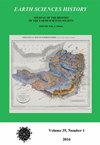海王星主义的遥远浅滩:美国中西部的威廉·h·基廷和圣彼得砂岩
IF 0.6
4区 哲学
Q4 GEOSCIENCES, MULTIDISCIPLINARY
引用次数: 0
摘要
威廉·h·基廷(William H. Keating, 1799-1840)作为矿物学家参加了斯蒂芬·h·朗少校(Major Stephen H. Long) 1823年对圣彼德河(明尼苏达)源头的考察,根据颗粒形状得出结论,圣彼德河砂岩(后来成为明尼苏达州斯奈林堡的典型剖面)是海水中的化学沉淀物。这似乎是对亚伯拉罕·戈特洛布·维尔纳(1749-1817)的海王星学说的呼应,在美国中西部得到了解释。虽然这一理论得到了著名地质学家詹姆斯·霍尔等人的认可,并以冰岛温泉中硅质烧结矿的沉积为例,为其提供了一些合理性,但随着沉积学的进一步发展,如查尔斯·l·戴克和乔治·a·蒂尔的研究,该理论的支持者所使用的“纯度”标准被发现是错误的。在20世纪40年代的砂岩三元分类中,“纯度”这个词与“成熟度”这个概念合并在一起,这是一种工业商业用语。因为圣彼得砂岩看起来毫无特色,演员们把他们潜在的偏见投射到砂岩露头的空白墙壁上。本文章由计算机程序翻译,如有差异,请以英文原文为准。
THE FAR SHOALS OF NEPTUNISM: WILLIAM H. KEATING AND THE ST. PETER SANDSTONE IN THE AMERICAN MIDWEST
William H. Keating (1799–1840) served as mineralogist on Major Stephen H. Long’s 1823 expedition to the source of the St. Peter’s (Minnesota) River, concluding, on the basis of grain shape, that the St. Peter Sandstone, at what was later to be its type section, Fort Snelling, in the state of Minnesota, was a chemical precipitate from seawater. This appears to be an echo of the Neptunist teachings of Abraham Gottlob Werner (1749–1817), as interpreted in the American Midwest. While endorsed by prominent geologist James Hall and others, and given some plausibility by the analogy of siliceous sinter depositing from hot springs in Iceland, the ‘purity’ criterion used by supporters of the theory was found fallacious with further advances in sedimentology such as those by Charles L. Dake and George A. Thiel. The word ‘purity,’ which was industrial-commercial parlance, merged into the concept of ‘maturity’ in the ternary sandstone classifications of the 1940s. Because the St. Peter Sandstone appears so featureless, actors projected their latent biases onto the blank walls of the sandstone outcrops.
求助全文
通过发布文献求助,成功后即可免费获取论文全文。
去求助
来源期刊

Earth Sciences History
GEOSCIENCES, MULTIDISCIPLINARY-HISTORY & PHILOSOPHY OF SCIENCE
CiteScore
1.00
自引率
0.00%
发文量
1
审稿时长
>12 weeks
期刊介绍:
Earth Sciences History promotes and publishes historical work on all areas of the earth sciences – including geology, geography, geophysics, oceanography, paleontology, meteorology, and climatology.
The journal honors and encourages a variety of approaches to historical study: biography, history of ideas, social history, and histories of institutions, organizations, and techniques.
Articles are peer reviewed.
 求助内容:
求助内容: 应助结果提醒方式:
应助结果提醒方式:


